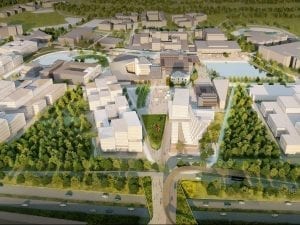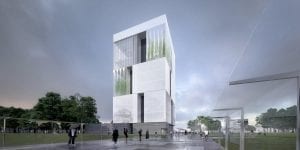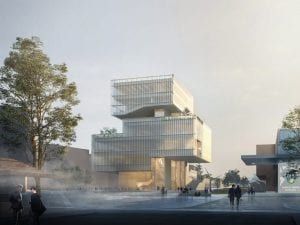University College Dublin’s Future Campus Competition Finalists Entry by Diller Scofidio + Renfro (© Diller Scofidio + Renfro) Entry by Diller Scofidio + Renfro (© Diller Scofidio + Renfro) Six design teams have been selected as finalists in the Future Campus – University College Dublin International Design Competition. The brief to competitors was to draw up an urban design vision that foregrounds a highly-visible and welcoming entrance precinct, and create a concept design for a charismatic yet integrated new 8,000 sqm building – the Centre for Creative Design – that expresses the University’s creativity. The Future Campus project is intended to create a stronger physical presence and identity for the University within Dublin, and raise the profile of UCD nationally and internationally.
The six teams (lead consultants listed in alphabetical order below with full details in theNotes to Editors) were selected in April by a panel chaired by the competition jury chair Professor Andrew J. Deeks, President of University College Dublin. The shortlist was expanded from the expected five to six in recognition of the outstanding response from the international design community.
- Diller Scofidio + Renfro(US)
- John Ronan Architects(US)
- O’Donnell + Tuomey(Ireland)
- Steven Holl Architects(US)
- Studio Libeskind(US)
- UNStudio(Netherlands)
The first stage of the competition, which sought expressions of interest detailing each competitor’s proposed team and experience, attracted 98 teams from 28 countries. Each finalist team will receive an honorarium of €40,000 for their competition work and international teams were required to team up with a local executive team for the second stage. Known as Ireland’s Global University, University College Dublin is the country’s largest and most internationally-engaged higher education body, the destination of choice for international students coming to Ireland. It is also the most popular choice for Irish students seeking a university place in their home country. Founded as an independent university 160 years ago by the visionary John Henry Newman, UCD has been a vital and influential force in shaping modern Ireland, both politically and culturally. UCD’s ability to foster creativity and expressiveness is reflected by alumni including the 20th century’s outstanding author, James Joyce; film maker Gabriel Byrne; and comedian Dara Ó Briain; as well as many successful architects and designers.
The competition jury will assess the final submissions and interview the teams in July, with the winner announcement anticipated for August. The jury consists of:
- Professor Andrew J. Deeks (Jury Chair), President, University College Dublin
- Sir David Adjaye, Principal, Adjaye Associates
- Ann Beha, Principal, Ann Beha Architects and Member, Harvard University Design Advisory Panel
- Joe Berridge, Partner, Urban Strategies, Inc.
- Professor Hugh Campbell, Professor of Architecture, Head of Subject and Dean, School of Architecture, Planning & Environmental Policy, University College Dublin
- Dermot Desmond, Chairman, International Investment & Underwriting
- Professor Orla Feely, Vice-President for Research, Innovation and Impact and Professor of Electronic Engineering, University College Dublin
- Professor David P. FitzPatrick, Principal, College of Engineering & Architecture and Dean of Engineering, University College Dublin and Provost, Beijing-Dublin International College
- Professor Michael Monaghan, Vice-President for Campus Development, University College Dublin
- Sean Mulryan, Founder, Chairman and CEO, Ballymore
- Dr Paul Thompson, Vice-Chancellor, Royal College of Art, London
The jury’s Administrative Chair is Malcolm Reading, Architect and Competition Director. Finalist Designs
Diller Scofidio + Renfro (US) with Scott Tallon Walker Architects, Sasaki Associates, GROSS. MAX., Arup, Atelier Ten, IN2 Engineering Design Partnership, Linesight, Michael Slattery Associates and i3PT Images © Diller Scofidio + Renfro
John Ronan Architects (US) with RKD Architects, CLUAA, BSM Landscape, Michael Boucher Landscape Architecture, Arup, Transsolar and Pritchard Themis Images © John Ronan Architects
O’Donnell + Tuomey (Ireland) with Allies and Morrison, Arup, Hargreaves Associates, Superposition, Plattenbau Studio, Phil Jones Associates, Max Fordham, MLM Group, Dermot Foley Landscape Architects and Horganlynch Images © O’Donnell + Tuomey
Steven Holl Architects (US) with Kavanagh Tuite Architects, Brightspot Strategy, Arup, HarrisonStevens and Transsolar Images © Steven Holl Architects
Studio Libeskind (US) with BDP, !melk, NRB, Dcon, Arup, Brock McClure Consultants, O’Herlihy Access Consultancy, JGA and i3PT Images © Studio Libeskind
UNStudio (Netherlands) with MOLA Architecture, Arup, REDscape Landscape & Urbanism, fwdesign, Maurice Johnson & Partners and i3PT  
 
Images © UNStudio |

1st Place: Zaha Hadid Architects – night view from river – Render by Negativ
Arriving to board a ferry boat or cruise ship used to be a rather mundane experience. If you had luggage, you might be able to drop it off upon boarding, assuming that the boarding operation was sophisticated enough. In any case, the arrival experience was nothing to look forward to. I recall boarding the SS United States for a trip to Europe in the late 1950s. Arriving at the pier in New York, the only thought any traveler had was to board that ocean liner as soon as possible, find one’s cabin, and start exploring. If you were in New York City and arriving early, a nearby restaurant or cafe would be your best bet while passing time before boarding. Read more… Young Architects in Competitions When Competitions and a New Generation of Ideas Elevate Architectural Quality 
by Jean-Pierre Chupin and G. Stanley Collyer
published by Potential Architecture Books, Montreal, Canada 2020
271 illustrations in color and black & white
Available in PDF and eBook formats
ISBN 9781988962047
Wwhat do the Vietnam Memorial, the St. Louis Arch, and the Sydney Opera House have in common? These world renowned landmarks were all designed by architects under the age of 40, and in each case they were selected through open competitions. At their best, design competitions can provide a singular opportunity for young and unknown architects to make their mark on the built environment and launch productive, fruitful careers. But what happens when design competitions are engineered to favor the established and experienced practitioners from the very outset? This comprehensive new book written by Jean-Pierre Chupin (Canadian Competitions Catalogue) and Stanley Collyer (COMPETITIONS) highlights for the crucial role competitions have played in fostering the careers of young architects, and makes an argument against the trend of invited competitions and RFQs. The authors take an in-depth look at past competitions won by young architects and planners, and survey the state of competitions through the world on a region by region basis. The end result is a compelling argument for an inclusive approach to conducting international design competitions. Download Young Architects in Competitions for free at the following link: https://crc.umontreal.ca/en/publications-libre-acces/ 
Helsinki Central Library, by ALA Architects (2012-2018)
The world has experienced a limited number of open competitions over the past three decades, but even with diminishing numbers, some stand out among projects in their categories that can’t be ignored for the high quality and degree of creativity they revealed. Included among those are several invited competitions that were extraordinary in their efforts to explore new avenues of institutional and museum design. Some might ask why the Vietnam Memorial is not mentioned here. Only included in our list are competitions that were covered by us, beginning in 1990 with COMPETITIONS magazine to the present day. As for what category a project under construction (Science Island), might belong to or fundraising still in progress (San Jose’s Urban Confluence or the Cold War Memorial competition, Wisconsin), we would classify the former as “built” and wait and see what happens with the latter—keeping our fingers crossed for a positive outcome. Read More… 
2023 Teaching and Innovation Farm Lab Graduate Student Honor Award by USC (aerial view)
Architecture at Zero competitions, which focus on the theme, Design Competition for Decarbonization, Equity and Resilience in California, have been supported by numerous California utilities such as Southern California Edison, PG&E, SoCAl Gas, etc., who have recognized the need for better climate solutions in that state as well as globally. Until recently, most of these competitions were based on an ideas only format, with few expectations that any of the winning designs would actually be realized. The anticipated realization of the 2022 and 2023 competitions suggests that some clients are taking these ideas seriously enough to go ahead with realization. Read more… 
RUR model perspective – ©RUR
New Kaohsiung Port and Cruise Terminal, Taiwan (2011-2020)
Reiser+Umemoto RUR Architecture PC/ Jesse Reiser – U.S.A.
with
Fei & Cheng Associates/Philip T.C. Fei – R.O.C. (Tendener)
This was probably the last international open competition result that was built in Taiwan. A later competition for the Keelung Harbor Service Building Competition, won by Neil Denari of the U.S., the result of a shortlisting procedure, was not built. The fact that the project by RUR was eventually completed—the result of the RUR/Fei & Cheng’s winning entry there—certainly goes back to the collaborative role of those to firms in winning the 2008 Taipei Pop Music Center competition, a collaboration that should not be underestimated in setting the stage for this competition Read more… 
Winning entry ©Herzog de Meuron
In visiting any museum, one might wonder what important works of art are out of view in storage, possibly not considered high profile enough to see the light of day? In Korea, an answer to this question is in the making. It can come as no surprise that museums are running out of storage space. This is not just the case with long established “western” museums, but elsewhere throughout the world as well. In Seoul, South Korea, such an issue has been addressed by planning for a new kind of storage facility, the Seouipul Open Storage Museum. The new institution will house artworks and artifacts of three major museums in Seoul: the Seoul Museum of Modern Art, the Seoul Museum of History, and the Seoul Museum of Craft Art.
Read more… |


























































